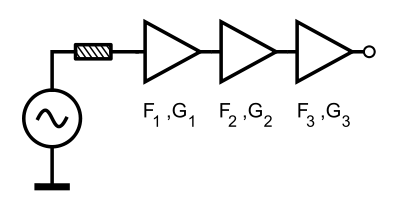Friis formulas for noise
Friis formula or Friis's formula (sometimes Friis' formula), named after Danish-American electrical engineer Harald T. Friis, refers to either of two formulas used in telecommunications engineering to calculate the signal-to-noise ratio of a multistage amplifier. One relates to noise factor while the other relates to noise temperature.
The Friis formula for noise factor

Friis's formula is used to calculate the total noise factor of a cascade of stages, each with its own noise factor and gain (assuming that the impedances are matched at each stage). The total noise factor can then be used to calculate the total noise figure. The total noise factor is given as
where and are the noise factor and available power gain, respectively, of the i-th stage, and n is the number of stages. Note that both magnitudes are expressed as ratios, not in decibels.
An important consequence of this formula is that the overall noise figure of a radio receiver is primarily established by the noise figure of its first amplifying stage. Subsequent stages have a diminishing effect on signal-to-noise ratio. For this reason, the first stage amplifier in a receiver is often called the low-noise amplifier (LNA). The overall receiver noise "factor" is then
where is the overall noise factor of the subsequent stages. According to the equation, the overall noise factor, , is dominated by the noise factor of the LNA, , if the gain is sufficiently high. (The resultant Noise Figure expressed in dB is 10 log(Noise Factor).)
The Friis formula for noise temperature
Friis's formula can be equivalently expressed in terms of noise temperature:
Printed references
- J.D. Kraus, Radio Astronomy, McGraw-Hill, 1966.